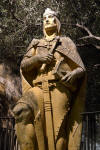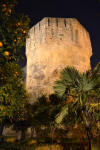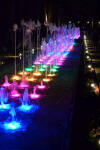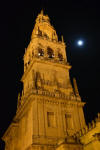Round The World and other travels
A frequent flyer's collection of trip diaries
December 2013: Cordoba
 Having
previously visited both
Seville and Granada,
I had been keen for some time on the idea of completing the
Andalusian trilogy with a visit to Cordoba. The opportunity
presented itself when I realised that I would be having a bit of
extra time off prior to Christmas 2013. Borrowing from previous
tactics when visiting Granada, I decided to fly British Airways to
Malaga, completing the journey by rental car and basing myself at a
Marriott Autograph Collection hotel at the destination. It
turned out to be a pleasant enough time of year to visit, with
tourist numbers fairly minimal. Mornings were cold all the way
through to lunchtime, afternoons were pleasantly warm (see photo)
and the cold returned quickly after dark.
Having
previously visited both
Seville and Granada,
I had been keen for some time on the idea of completing the
Andalusian trilogy with a visit to Cordoba. The opportunity
presented itself when I realised that I would be having a bit of
extra time off prior to Christmas 2013. Borrowing from previous
tactics when visiting Granada, I decided to fly British Airways to
Malaga, completing the journey by rental car and basing myself at a
Marriott Autograph Collection hotel at the destination. It
turned out to be a pleasant enough time of year to visit, with
tourist numbers fairly minimal. Mornings were cold all the way
through to lunchtime, afternoons were pleasantly warm (see photo)
and the cold returned quickly after dark.
The city lies approximately 160km north of Malaga. Established during Roman times, it later became capital of the Islamic Caliphate of Cordoba and during the 10th and 11th centuries rose to become one of the most important cities in the world. It had declined to a small town by the 18th century, but grew again in the 20th century to reach its present size of over 300,000 inhabitants. The entire old town area has been inscribed as a UNESCO World Heritage Site, the largest urban area at the time to have achieved this distinction. The name is written as Córdoba in Spanish to indicate that the stress falls on the first syllable.
The Mezquita
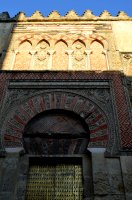
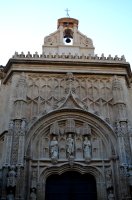 The standout, must-see attraction in Cordoba is
the Mezquita ('Mosque'), also referred to as the
Mezquita-Catedral ('Mosque-Cathedral'). The main part of the
complex is a large medieval mosque, said to be based on the Great
Mosque of Damascus and regarded as one of the finest examples of
Moorish architecture in the world. Following the Reconquista
in 1236, the mosque was converted into a Catholic church, the
minaret becoming its bell tower. Later, amid much controversy, a
Renaissance cathedral was erected right in the centre of the
centuries-old and much revered building. A dismayed King Charles V is said to have
commented in the sixteenth century that "they have taken something
unique in all the world and destroyed it to build something you can
find in any city."
The standout, must-see attraction in Cordoba is
the Mezquita ('Mosque'), also referred to as the
Mezquita-Catedral ('Mosque-Cathedral'). The main part of the
complex is a large medieval mosque, said to be based on the Great
Mosque of Damascus and regarded as one of the finest examples of
Moorish architecture in the world. Following the Reconquista
in 1236, the mosque was converted into a Catholic church, the
minaret becoming its bell tower. Later, amid much controversy, a
Renaissance cathedral was erected right in the centre of the
centuries-old and much revered building. A dismayed King Charles V is said to have
commented in the sixteenth century that "they have taken something
unique in all the world and destroyed it to build something you can
find in any city."
The Renaissance insertion into a building that was already of great historical importance will probably remain contentious until the end of time. Some continue to regard it as an officially sanctioned act of vandalism, perpetrated for the purpose of making a robust political statement. Looked at several centuries after the event, however, and from the point of view that what's done is done, the king's condemnation seems maybe just a little too harsh. For one thing, the fact that 90% of the complex survives structurally intact suggests that the alteration, while drastic, was undertaken with at least a modicum of sensitivity. And secondly, the newer part of the building is itself absolutely magnificent. Perhaps a more measured assessment would be that they took something unique in all the world and partially destroyed it to create a new section, which when fused with the original building, formed a whole that was once again unique in the world.
As I entered the building on a cold December morning and began to stroll through an enchanted indoor forest of marble columns and striped arches, I was instantly transported to another part of the globe and a different culture. It was a living evocation of that part of Spain's history that makes it so different from every other country in western Europe. It was also a wander through a three-dimensional geometry lesson that was at the same time both ancient and yet live and interactive; a place full of mathematical logic and precision, yet seemingly endless and disorientating. The illusion was intermittent: this outermost part of the building was also home to a large number of Christian shrines and side-chapels, where the graphic art forms of western painting and statuary stood in sharp contrast to the abstract and ethereal beauty of the original Islamic design.
After paying a short visit to the Treasury, I approached the central core of the building and was prepared to be either appalled or impressed as appropriate, depending on how well the infamous alteration had been executed. I caught sight of the soaring ceiling first, elaborately carved and decorated, and audibly gasped. Whatever the rights and wrongs of the concept, I was in no doubt that the end result was something strikingly beautiful. Thankfully, the cathedral authorities have an enlightened approach to responsible photography, otherwise I wouldn't be able to illustrate all these powerful impressions. Visitors are welcome to take pictures provided they steer clear of flash and tripods.
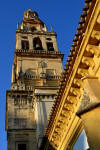 |
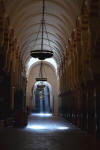 |
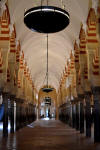 |
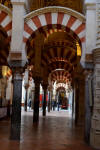 |
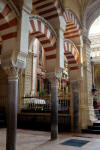 |
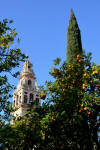 |
 |
 |
 |
 |
 |
 |
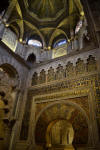 |
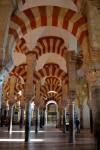 |
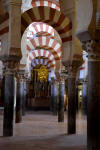 |
 |
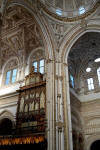 |
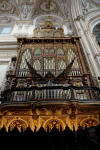 |
 |
|||||
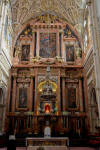 |
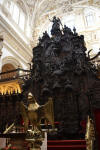 |
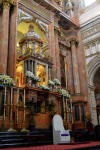 |
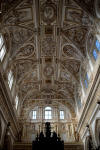 |
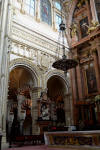 |
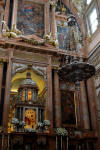 |
Alcázar de los Reyes Cristianos
The Palace of the Christian Monarchs - the first word is a transcription of the Arabic Al-Qasr - occupies a prime riverside position in the historic old town, extending from the Puente de San Rafael more than halfway to the Roman Bridge. The monarchs in question are Ferdinand II of Aragon and Isabella I of Castile, founders of the dreadful Spanish Inquisition. This organisation maintained an active presence here for three centuries, converting the old Arab baths into interrogation rooms and torture chambers.
The Spanish government turned the Alcázar into a tourist attraction in the 1950s. Formal gardens and water features now hint at the splendour of the former caliph's residence that once occupied the site, and help to disguise the grisly events that took place between that time and now.
 |
 |
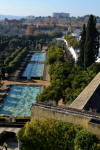 |
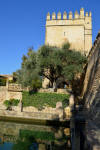 |
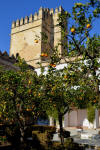 |
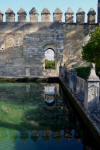 |
 |
 |
The Old Town
Cordoba's old town is a maze of medieval streets and alleys surrounding the Mezquita, characterised by the area's whitewashed buildings.
 |
 |
 |
 |
 |
 |
 |
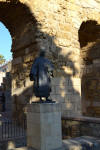 |
 |
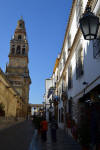 |
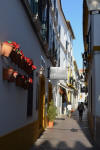 |
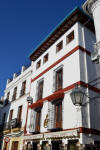 |
 |
|||||
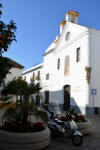 |
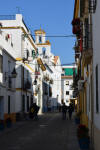 |
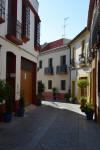 |
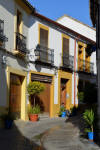 |
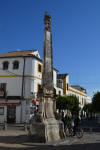 |
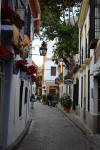 |
The River
Like Seville further downstream, Cordoba lies on the Guadalquivir river. The main point of interest here is the Roman Bridge, which dates from the 1st century BC. It underwent extensive restoration during the 10th century and again as recently as 2006. Entry to the bridge from the city side is marked by a triumphal arch known as the Puerta del Puente - literally, the Bridge Gate.
 |
 |
 |
 |
 |
 |
Outside the World Heritage Site
While there is clearly lots within the old town area to keep visitors occupied, a wander in less ancient parts of the city can also be rewarding.
 |
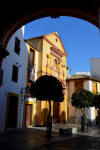 |
 |
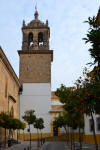 |
 |
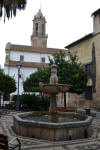 |
 |
 |
 |

